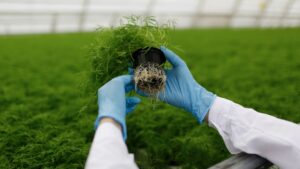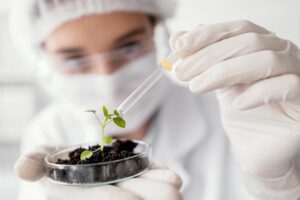From an agricultural standpoint, examining the soil is essential since it provides more than simply a foundation for crops and a supply of water and minerals. It is a complex living system where various elements, including organisms, minerals, water, vegetation, and air, interact. As a result, healthy soil is essential for the long-term provision of agricultural output and ecological services. Soil testing can help you manage your health and increase agricultural output. Soil analysis can be done in labs.
Farmers need soil-testing procedures to assess soils for potential plant-available nutrients. Soil testing is the foremost best management practice (BMP). It helps farmers achieve profitable crops while protecting the environment from excessive fertilization and nutrient losses.
Why should farmers opt for soil analysis and testing?
Plants need 17 essential and crucial nutrients to function and perform their routine physiological processes. Of these nutrients, three nutrients exist in air and water: carbon (C), hydrogen (H), and oxygen (O). The other 14 nutrients come from the soil. Not all plants need these nutrients in the exact same quantities. Some nutrients, like nitrogen (N), phosphorus (P), and potassium (K), are required in more significant amounts than others. They are also called primary macronutrients. Plants need other nutrients in lesser quantities like magnesium (Mg), calcium (Ca), and sulphur (S), which are known as secondary macronutrients. There is a third category of nutrients called the micronutrients, which plants require in tiny amounts. They are boron (B), copper (Cu), chlorine (Cl), manganese (Mn), iron (Fe), molybdenum (Mo), nickel (Ni) and zinc (Zn).
Since human eyes cannot see, touch, or count nutrients through their naked eyes, they depend on scientific instruments in soil data analysis to measure them.

German scientist Justus von Liebig had proposed the “Law of the Minimum” in the 19th century. It also states that if one of the essential plant nutrients are deficient, plant growth will be affected, even when all other vital nutrients are abundant. That is why after the harvest of cash crops every fall , farmers complete a soil snalysis process which could include soil mapping or collecting representative soil cores from a depth of about 4 to 6 inches at several locations on their farm. They then send them to a soil testing laboratory for analysis.
The need for testing soil nutrients
At particular phenological stages in their life cycles, plants need specific nutrients. Low concentrations of nutrients severely impede plant growth, while high concentrations of nutrients, such as nitrogen, cause plant withering, fertilizer burns, or abnormal development. Numerous interactions exist between the chemical, biological, and physical processes in soil. These interrelationships need to be in check if cultivable plants are to thrive and yield copious amounts of fruit.
Its nutritional content significantly affects agricultural productivity and crop yields. Certain plant species are more susceptible than others to lousy weather. Diseases can grow into a veritable army if low quality, poor mineral element absorption, salinity, and depletion are added to the mix. Farmers mostly use their eyes to make decisions on fertilizers. Even an experienced professional can make blunders when using this strategy because of the inherent uncertainty that external signals introduce. If one of the required components is lacking or present in excess, the flow of other crucial components may be impeded.
Significant nutrients in the soil
Potassium, phosphorus, and nitrogen are the three major nutrients. Calcium, sulphur, magnesium, iron, manganese, boron, and molybdenum are secondary nutrients for plants in the soil. Each nutrient has a limited supply that different crops require. It may be administered to the ground depending on the availability and nutrient shortage based on the lab’s soil test analysis report.
When to go for soil sampling?
Soil sampling is often done in the fall after harvest or in the spring before fieldwork but should always be done before applying fertilizer. It is essential to be consistent during the time of soil sampling (i.e. always in the fall or continuously in the spring). Samples should be taken in every 2 to 4 years or at least once in a crop rotation. Farmlands should be in the same crop each time when sampled to help reduce the variability of test results.

What soil sampling method should be used?
Soil samples can be collected in the following manner:
Whole field sampling -
Collect small pieces to represent the entire field. It is typically not recommended because you cannot capture field variability.
Grid sampling -
Field is broken into square grids (1.1 acres to 10-acre grids), and a sample represents a grid.
Management zone sampling -
The field is separated into management zones for soil sampling depending on a combination of prior experience, field history, the soil survey maps, yield maps, topography, etc.
High Density Soil Mapping-
Utilizing sensor technologies to measure and model variability across the field, typically coupled with traditional sampling to provide a highly detailed map of the field in order to make specific, accurate management or amendment decisions.
Whatever method you choose, each sample should be a composite of at least 10 to 15 cores. Besides, it is ideal that a sample should only represent approximately 10 acres if available information suggests larger field areas have slight variation, like in soil type or yield potential. Multiple sampling areas per field aid to determine if a uniform application rate or a varying or site-specific rate of fertilizer application, manure, or lime is more appropriate.
Cores must be taken from a combination of locations–in the row, between the row, or mid-way between the row and not just in a tiny radius. This is especially crucial if fertilizer or manure is banded. Samples should represent the sample area or zone as completely as possible.
The outcomes of soil analysis
Once a soil testing laboratory gets the soil, lab dries, grinds, and sieves the soil sample to make it uniform before conducting the tests. Then, they conduct the requested tests designed to quantify nutrients in the soil. The results provide information on the soil’s nutrient-supplying capacity – primarily phosphorus, potassium, and micronutrients.
The results showing the nutrient concentrations are then evaluated. Upon completing the analysis, an expert such as a soil scientist interprets the development and information about which crops need what nutrients to grow best. They then report what is in the soil and how much additional fertilizer would be required to achieve optimal yields depending on the crops grown.
The laboratory then dispatches the report to the farmer with their findings and offers recommendations for nutrient applications. Farmers also often recruit or consult an expert agronomist who analyses the soil test report and recommends how much and when to apply fertilizers. Farmers often collect and send soil samples every one or two years. Maintaining a detailed record of soil test reports also gives valuable information on long-term changes in attaining soil fertility. This permits farmers to make better decisions on soil fertility management to get optimum yields.
